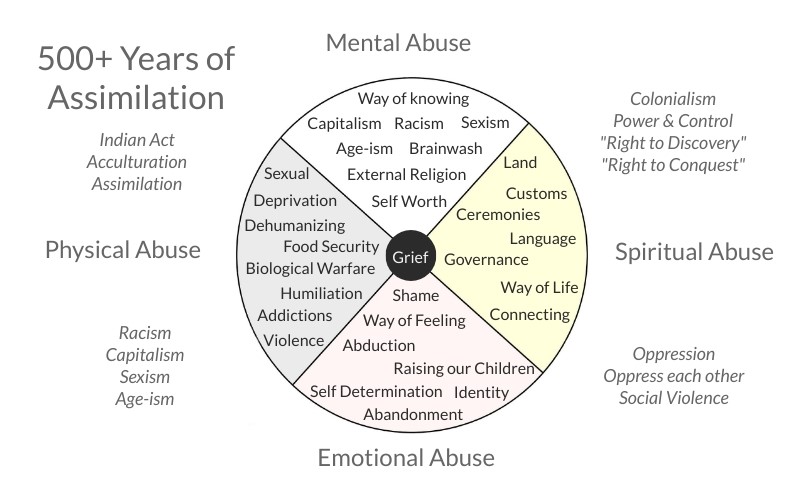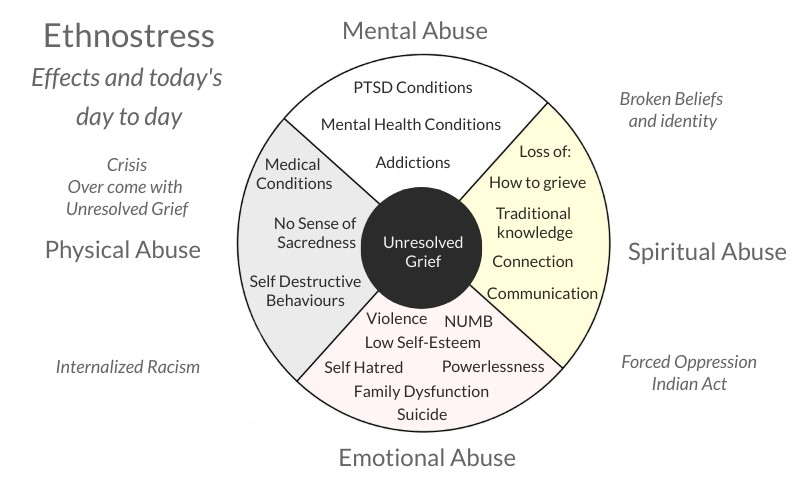8
Learning Objectives
Enhancing the skillset to identify the oppressive behaviours in Indigenous Communities, to enable support, healing and engagement in a non-threatening approach
- Examining the damage and effects of historical trauma on family systems; and
- Examining the damage and effects of colonization on communities.
- Examining the effects of personal traumas (shame) has on an individual.
500 Years of Colonization
Indigenous worldviews are represented in the form of the wheel, to symbolize what was lost, and the abuses gained in each level of wellness. Take special note of the black circle in the center, what goes there?
Grief: is the response to loss, particularly to the loss of someone or something that has died, to which a bond or affection was formed. Although conventionally focused on the emotional response to loss, it also has physical, cognitive, behavioral, social, cultural, spiritual and philosophical dimensions.[1] (Remembering with Indigenous Worldview and deep relationships with the environment, language, ceremonies, customs and traditions).
In Indigenous cultures, there were ceremonies to help a person grieve. Those ceremonies became illegal, Dr. Maria Yellow Horse Brave Heart alludes to the fact that we have become nations that hold unimaginable amounts of grief over lifetimes, because the right to process it was stolen and replaced with alcohol, domestic violence, and greed. “Acute grief which persists becomes unresolved, prolonged, and complicated.” She refers to this as Intergenerational Trauma.
Intergenerational Trauma, defined by Dr. Maria Yellow Horse Brave Heart is:
- Cumulative
- Emotional, psychological, social, and spiritual wounding
- Over the lifespan and across generations
- Resulting from massive group trauma
This is Complex Post-Traumatic Stress Response. Complex, because it is cumulative over generations.
Another focus that Dr. Maria Yellow Horse Brave Heart makes is:
-
“Limited Bereavement” – there are processes to look after the dead physically and spiritually. These processes were to help the living grieve and to stay connected spiritually. For Indigenous people “grief was invalidated”, because Indigenous peoples were dehumanized.
- In the time of epidemics of plagues, there was an increased death toll that included all types of people: leaders, healers, knowledge keepers, orators. In the wake, it was the people that were left to help the people the best that they could.
Intergenerational Trauma
Effects from Ethno-Stress
Ethnostress: comes from two words; “ethnicity” which refers to the roots of our aboriginal identity and “stress” pertaining to the impact that the reality of our experience has on the development of the aboriginal person,[2] and their day to day life experience.
Reflecting on the wheel, that symbolizes the layering of the various aspects of identity that were lost. Take special note of the black circle in the center, what happened?
The unresolved grief becomes larger over time and over generations.
Acculturation – is a process of social, psychological, and cultural change that stems from the balancing of two cultures while adapting to the prevailing culture of the society. Acculturation is a process in which an individual adopts, acquires and adjusts to a new cultural environment. Individuals of a differing culture try to incorporate themselves into the new more prevalent culture by participating in aspects of the more prevalent culture, such as their traditions, but still hold onto their original cultural values and traditions. The effects of acculturation can be seen at multiple levels in both the devotee of the prevailing culture and those who are assimilating into the culture.[3]
Dr. Maria Yellow Horse Brave Heart has done extensive research and has listed multiple symptoms of trauma, and multigenerational trauma that can be seen across Indigenous Communities. Some include:
- Depression
- PTSD Symptoms
- Psychic numbing
- Fixation to trauma
- Low self esteem
- Anger
- Self-destructive behaviours, self hatred
- Suicidal Ideation
- Hypervigilance
- Intense Fear
- Dissociation
Dr. Martin Brokenleg identifies symptoms of Trauma in Indigenous life as:
- Child Neglect and Abuse
- Incarceration
- Early Death
- Violence
- Addiction
- Suicide
Shame: the intense painful feeling or experience of believing that we are flawed and therefore unworthy of love and
belonging. “I am bad.” “I am a mess.” The focus is on self, not behaviour, with the result that we feel alone. Shame is never known to lead us toward positive change.[4]
- Shame is universal, we all have it, it is most primitive emotions humans have.
-
- Lack capacity of empathy & making connections
- We all are afraid to talk about it, it makes us uncomfortable.
- The less we talk about it, the more it has control over our lives.
Ethno-stress, oppressive behaviour patterns seen in Indigenous Communities
From Tribal Sovereignty Associates, full description Appendix
|
|
|
Needs are Frozen
Internalized negative messages about identity, interferes with fulling basic and essential needs as a human and indigenous person. The pain and hurt experienced, prevents a person from fully being open and connected which effects all relationships.
Loss of Faith and Belief
Loss of faith and cultural beliefs under the influence of systemic racism and colonialism; extends to the loss of the faith and believe in ourselves, in our family, and in our community. This can cause a person feeling lost and confused leaving us vulnerable.
The Hostage Syndrome
Describes the psychological effects of captivity on an individual. When a person begins to adapt to the loss of freedom by accepting and supporting the beliefs of his or her captor. Examples are disenfranchisement, passes to leave reserves, Indian Residential Schools.
The Narrowing of Culture
The loss of homeland and mobility with the reservation system, limited the Cultural lifeways dictated by various religious and governmental controls. Today there are people who have never left the reserve, they have strong beliefs of the majority culture and reject anything that has to do with “traditional” ways.
Culture Under Glass
The entire Indigenous culture is “frozen”. The Canadian narrative is reinforced by the history books that talk about aboriginal people and cultures in the past tense, leading the belief that they no longer exists, and there, have no claim to land or other rights.
Tribal Isolation
Défense patterns are developed, which leads us to withdraw and to isolate ourselves from other aboriginal people. Fear and mistrust from pain caused by hurt from our own people, can cause shame which leads to isolation and barrier that keeps us separate.
Internal Stereotypes
The Hollywood film industry influenced stereotypical images of what an indigenous male and female should be in the 20th century. These images created images in the minds of both indigenous and non-indigenous people that are not a true representation of the roles defined by our culture and traditions.
Internal Fractionalism
Often, effective community leaders and organizers become “burnt-out” from their attempts to work in a community where people are very negative and highly critical of leadership. Behaviour patterns that attack, criticize or have unrealistic expectations of anyone who has the courage to step forward and undertake leadership responsibilities within the community.
Adopting of “Survivalist” Behaviours
The “survivalist” develops way to “cope” with all of the oppressive situations he or she experiences in life. To survive, we learn to “shut down” our feelings so that we can silently withstand humiliation and criticism. We do so in an attempt to prevent ourselves from once again being hurt, rejected, or trapped by someone else. We learn not to show or to share our feelings with others and in the process, we learn how to isolate ourselves to the point where we may not understand or be able to feel our own emotions. Survivalist behaviours can be scary when in our attempt to protect ourselves, we fail to comprehend the feelings and emotions of those individuals closest to us, namely our spouses and our children.
Media Attributions
- 300 Years of Colonization grief 1
- Effects from Ethno-Stress

